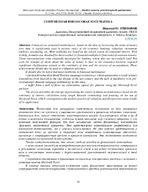| dc.contributor.author | Трифонов, Н. Ю. | |
| dc.coverage.spatial | Chișinău | ru |
| dc.date.accessioned | 2022-09-02T05:40:39Z | |
| dc.date.available | 2022-09-02T05:40:39Z | |
| dc.date.issued | 2022 | |
| dc.identifier.citation | Трифонов, Н. Ю. Современная финансовая математика / Н. Ю. Трифонов // Abordări moderne privind drepturile patrimoniale : materialele monferinței științifico-practice internaționale : organizată cu prilejul aniversării 25 ani de la fondarea specialității „Evaluarea imobilului” și 20 ani a programului de studiu „Drept patrimonial”, 12-13 mai, 2022 / comitetul ştiinţific: Svetlana Albu [et al.]. – Chişinău : MS Logo, 2022. – P. 14-20. | ru |
| dc.identifier.uri | https://rep.bntu.by/handle/data/118507 | |
| dc.description.abstract | Financial (or actuarial) mathematics, based on the idea of increasing the value of money over time, is significantly used in various areas of the economy: banking, valuation, investment analysis, accounting, etc. Most textbooks are based on the school course of compound interest. With its help, formulas are obtained for the so-called six financial multipliers (functions) of constant interest. These representations were originally developed for banking, where they are successfully used. But even the transfer of ideas about the value of money in time to the insurance business required significant clarifications related to the continuity of time and the process of accumulation. These achievements should also be used in evaluation activities. It should also be noted that many textbooks in financial mathematics - use cumbersome disordered Russian-language terminology, which appeared as a result of hasty translations from English in the last decade of the last century and the lack of familiarity with prerevolutionary Russian-language terminology in this area, - suffer from a lack of focus on calculations typical for practice using the Microsoft Excel package. The article describes the concept of presenting the course of financial mathematics based on the continuity of interest calculation using simple Russian terminology and focusing on the use of Microsoft Excel, which corresponds to the modern practice of valuation, and also presents some results of its application. | ru |
| dc.language.iso | ru | ru |
| dc.publisher | MS Logo | ru |
| dc.title | Современная финансовая математика | ru |
| dc.type | Working Paper | ru |
| local.description.annotation | Финансовая (или актуарная) математика, основанная на идее повышения стоимости денег со временем, существенно применяется в различных областях экономики: банковском деле, оценке стоимости, инвестиционном анализе, бухгалтерском учёте и др. В основе изложения в большинстве учебников лежит школьный курс сложного процента. С его помощью получаются формулы для так называемых шести финансовых множителей (функций) постоянного процента. Эти представления первоначально разработаны для банковской деятельности, где с успехом используются. Но уже перенос представлений о стоимости денег во времени в страховое дело потребовало существенных уточнений, связанных с непрерывностью времени и процесса накопления. Эти достижения необходимо использовать и в оценочной деятельности. Также следует отметить, что многие учебные пособия по финансовой математике - используют громоздкую неупорядоченную русскоязычную терминологию, появившуюся в результате поспешных переводов с английского языка в последнее десятилетие прошлого века и отсутствия знакомства с дореволюционной русскоязычной терминологией в этой области, - страдают отсутствием ориентации на типичные для практики расчёты с помощью с помощью пакета Microsoft Excel. В статье описана концепция изложения курса финансовой математики на основе непрерывности начисления процента с использованием простой русскоязычной терминологии и ориентацией на применение Microsoft Excel, отвечающая современной практике оценки стоимости, а также приведены некоторые результаты её применения. и ориентацией на применение Microsoft Excel, отвечающая современной практике оценки стоимости, а также приведены некоторые результаты её применения. | ru |

